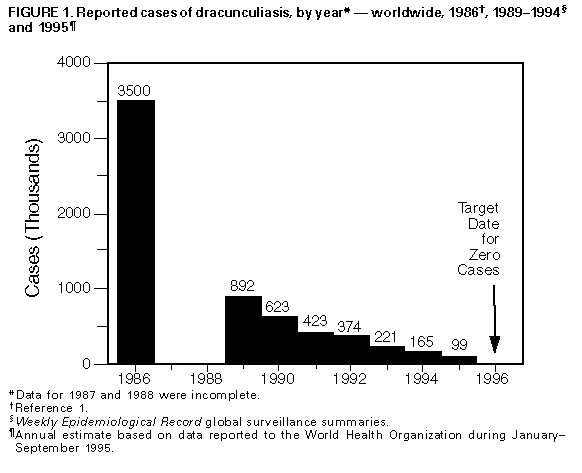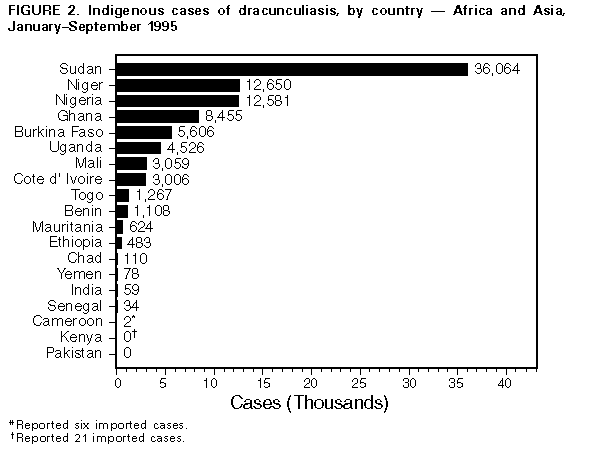 |
|
|
|
|
|
|
| ||||||||||
|
|
|
|
|
|
|
||||
| ||||||||||
|
|
|
|
|
Persons using assistive technology might not be able to fully access information in this file. For assistance, please send e-mail to: mmwrq@cdc.gov. Type 508 Accommodation and the title of the report in the subject line of e-mail. Progress Toward Global Eradication of DracunculiasisThe plan for the global eradication of dracunculiasis (i.e., Guinea worm disease) was developed in October 1980, when dracunculiasis was known to be endemic in 16 African countries, India, and Pakistan. In 1991, the World Health Assembly adopted a resolution to eradicate dracunculiasis by the end of 1995. This report summarizes the substantial progress toward eradication of dracunculiasis since the beginning of this effort. From 1986 through 1995, the total number of dracunculiasis cases will have declined by 97%, from approximately 3.5 million (1) to a projected 100,000 Figure_1. This decline occurred even though only four of 19 countries began eradication programs before 1990. During January-September 1995, a total of 89,739 cases were reported Figure_2, a decrease of 32% from the 131,607 cases reported during the same period in 1994 (2). In addition, the number of villages with endemic disease decreased from approximately 23,000 in 1992 to approximately 8000 in 1995. A total of 19 countries reported on cases of dracunculiasis during January-September 1995 Figure_2. Pakistan has reported no cases since October 1993 (3), and Kenya has reported no indigenous cases since April 1994. Local transmission appears to have been interrupted in Cameroon (from which two indigenous cases were reported in 1995), India (59 cases), and Senegal (33 cases). Chad, Ethiopia, Mauritania, and Yemen each are projected to report less than 800 cases in 1995. Dracunculiasis remains most endemic in Niger, Nigeria, and Sudan; these countries accounted for 68% of reported cases (4,5). By September 1995, all countries with endemic disease were implementing the "case-containment" strategy (6,7) in which village-based health workers (VBHWs) attempt to detect each person with an infection and initiate control measures within 24 hours of emergence of the worm. As of July 1995, workers in approximately 80% of villages with known endemic disease had been trained and provided with resources for implementing this strategy, compared with 52% in December 1994. From January through September 1995, approximately 33% of reported cases had been contained, although the criteria used to measure such containment varied among the countries. In addition, trained VBHWs are present in approximately 90% of villages with endemic disease. Except in Sudan, most villages with endemic disease provide monthly reports of cases of dracunculiasis. Because Abate{Registered} * (temephos) is not suitable for use in all affected villages, only approximately 15% of villages with endemic disease are using this intervention for vector control. Reported by: Global 2000, The Carter Center, Atlanta. Dracunculiasis Eradication Unit, Div of Control of Tropical Diseases, World Health Organization. World Health Organization Collaborating Center for Research, Training, and Eradication of Dracunculiasis, Div of Parasitic Diseases, National Center for Infectious Diseases, CDC. Editorial NoteEditorial Note: Most national programs for eradicating dracunculiasis can rapidly detect and contain residual cases. The findings in this report indicate that, because of intensified surveillance and case-containment efforts during 1995, the number of incident cases should be reduced even further during 1996. Although the primary target dates for both the global Smallpox Eradication Program and the regional Polio Eradication Program in the Americas were not achieved (1976 and 1990, respectively), these programs succeeded in eradication within 10 and 8 months of the goals, respectively. In the absence of a specific therapy to cure the infection and because of the prolonged incubation period (12 months), eradication of dracunculiasis is likely to be delayed even more beyond the target date. Factors associated with the duration to eradication include the willingness of countries to intensify their commitment and the timely deployment of appropriate technical, financial, and diplomatic resources. References
* Use of trade names and commercial sources is for identification only and does not imply endorsement by the Public Health Service or the U.S. Department of Health and Human Services. Figure_1  Return to top. Figure_2  Return to top. Disclaimer All MMWR HTML versions of articles are electronic conversions from ASCII text into HTML. This conversion may have resulted in character translation or format errors in the HTML version. Users should not rely on this HTML document, but are referred to the electronic PDF version and/or the original MMWR paper copy for the official text, figures, and tables. An original paper copy of this issue can be obtained from the Superintendent of Documents, U.S. Government Printing Office (GPO), Washington, DC 20402-9371; telephone: (202) 512-1800. Contact GPO for current prices. **Questions or messages regarding errors in formatting should be addressed to mmwrq@cdc.gov.Page converted: 09/19/98 |
|||||||||
This page last reviewed 5/2/01
|